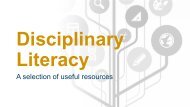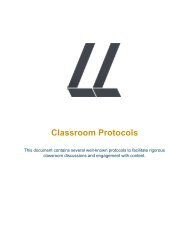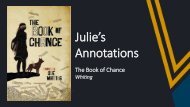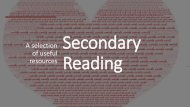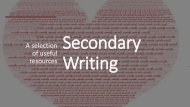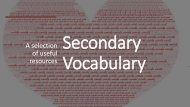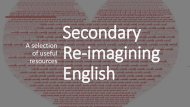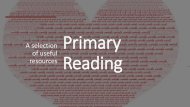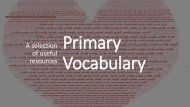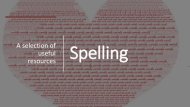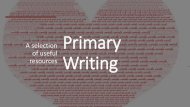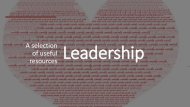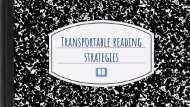Content Area Resources Magazine
Create successful ePaper yourself
Turn your PDF publications into a flip-book with our unique Google optimized e-Paper software.
<strong>Content</strong> <strong>Area</strong><br />
Literacy<br />
A selection of useful resources<br />
This Photo by Unknown Author is licensed under CC BY-NC-ND
Daniels and Zemelman, two of America’s most popular<br />
educators, share exactly what you need to help students<br />
read your nonfiction content closely and strategically:<br />
• 27 proven teaching strategies that help meet—and<br />
exceed—the standards<br />
• how-to suggestions for engaging kids with content<br />
through wide, real-world reading<br />
• a lively look at using “boring” textbooks<br />
• motivating instruction that’s powered by student<br />
collaboration<br />
• specifics for helping struggling readers succeed.<br />
Subjects Matter, Second Edition enables deep, thoughtful<br />
learning for your students. You’ll discover fresh and reenergized<br />
lessons, completely updated research, and<br />
vibrant vignettes from new colleagues and old friends who<br />
have as much passion for their subjects as you do.<br />
“We’ll be using methods particular to our fields as well as<br />
engaging reading materials that help students understand<br />
and remember our content better,” write Harvey and Steve.
Stephanie Harvey and Anne Goudvis share the work and<br />
thinking they've done since second edition and offer new<br />
perspectives on how to explicitly teach thinking strategies so<br />
that students become engaged, thoughtful and independent<br />
readers.<br />
Thirty new lessons and new and revised chapters highlight<br />
children's thinking, curiosity, and questions.<br />
Harvey and Goudvis tackle close reading, close listening,<br />
text complexity, and critical thinking in a new chapter on<br />
building knowledge through thinking-intensive reading and<br />
learning.<br />
Other fully revised chapters focus on digital reading,<br />
strategies for integrating comprehension and technology,<br />
and comprehension across the curriculum.<br />
Strategies That Work (3 rd edition) explains the research<br />
behind comprehension and looks at 8 strategies that should<br />
be explicitly taught to students to increase their<br />
comprehension of text. It also provides lesson ideas and<br />
student work samples.
Serves as a guide for teachers who want to realize the benefits of<br />
well-structured, student-led, cross-curricular projects. Lays the<br />
foundation for inquiry circles by chronicling the current research<br />
and practices behind comprehension instruction and classroom<br />
collaboration.<br />
• 37 strategy lessons, including 11 completely new ones, for<br />
thinking and collaboration<br />
• 7 new step-by-step classroom stories that model inquirybased<br />
units<br />
• Groundbreaking research in comprehension, collaboration,<br />
and inquiry<br />
• Connections to inquiry structures such as makers, design<br />
thinking, genius hour, and capstone projects<br />
• Tips on common questions about management and<br />
accountability<br />
• A completely rewritten chapter on the wise use of<br />
technology<br />
• Specific correlations from inquiry circles to common state<br />
and national standards.
In Closing the Reading Gap, Alex Quigley explores the intriguing<br />
history and science of reading, synthesising the debates and<br />
presenting a wealth of usable evidence about how children<br />
develop most efficiently as successful readers.<br />
Offering practical strategies for teachers at every phase of their<br />
teaching career, as well as tackling issues such as dyslexia and<br />
the role of technology, the book helps teachers to be an expert in<br />
how pupils ‘learn to read’ as well as how they ‘read to learn’ and<br />
explores how reading is vital for unlocking a challenging<br />
academic curriculum for every student.<br />
With a focus on nurturing pupils’ will and skill to read for pleasure<br />
and purpose, this essential volume provides practical solutions to<br />
help all teachers create a rich reading culture that will enable<br />
every student to thrive in school and far beyond the school gates.
This pioneering book is now in a revised and expanded<br />
second edition featuring the latest neuroscientific<br />
knowledge and instructional strategies.<br />
Kelly B. Cartwright provides a teacher-friendly<br />
explanation of executive skills--such as planning,<br />
organization, cognitive flexibility, and impulse control--<br />
and their role in reading comprehension.<br />
Detailed examples illustrate how each skill is deployed by<br />
strong comprehenders and ways to tailor instruction for<br />
students who are struggling.<br />
The companion website features reproducible planning<br />
and assessment forms from the book as well as<br />
supplemental card sorts to teach and assess cognitive<br />
flexibility, all ready to download and print in a convenient<br />
8 1/2" x 11" size.
In the same teacher-friendly, classroom-wise voices that made Subjects<br />
Matter and <strong>Content</strong>-<strong>Area</strong> Writing bestsellers, Daniels and Steineke<br />
prove that with the right materials and the right lessons, you can turn<br />
your kids into much better readers in your subject field by showing:<br />
• how proficient readers think<br />
• how skillful collaborators act<br />
• how to use quick and engaging activities that add to, not steal from<br />
subject-matter learning.<br />
Each real-world text was chosen for its subject-area relevance, its<br />
interest to teens, and for its “wow factor”—the texts most likely to<br />
engage kids in discussion and debate.<br />
Step-by-step lessons accompany each text, including:<br />
• 23 Strategy Lessons that focus closely on at least one key<br />
comprehension strategy or collaboration skill that proficient learners<br />
use, and address the Common Core Standards for ELA<br />
• 10 Text Set Lessons that directly align to commonly taught<br />
curricular topics and offer a deeper, longer engagement in the<br />
subjects and strategies at hand.
<strong>Content</strong>-<strong>Area</strong> Writing guides you strategically through the two<br />
major types of writing that every student must know:<br />
• Writing to Learn: the quick, exploratory, and extemporaneous<br />
in-class writing that helps kids engage deeply with content, build<br />
connections, and retain what they've learned<br />
• Public Writing: planned, constructed, and polished writing in<br />
which students demonstrate knowledge and reflect on what<br />
they've learned.<br />
Daniels, Zemelman & Steineke provide valuable lessons for<br />
encouraging growth in both types of writing with subject-specific<br />
ideas for planning, organising, and teaching, as well as samples of<br />
student work and guidelines for evaluation and assessment.<br />
They also include detailed information on how their strategies fit<br />
into the writing process, how they can be used in writing workshops<br />
across the curriculum, and how they prepare students for testing<br />
and other on-demand writing situations.
In this book, Gallagher emphasises the need for students to write for<br />
real-world purposes. He provides practical strategies that are based<br />
on his own long experience as a high school teacher, with the<br />
purpose of teaching students to work with specific forms of discourse.<br />
These are, express and reflect, inform and explain, evaluate and<br />
judge, inquire and explore, analyse and interpret, and take a<br />
stand/propose a solution.<br />
Gallagher suggests mentor texts, provides student writing samples<br />
and indicates the sort of assignments that are likely to grow your<br />
student writers.
In this book the author provides teachers with practical<br />
information and strategies to teach non-fiction writing across all<br />
subjects.<br />
Peery explains simple strategies and shares implementation<br />
ideas about how writing can be used in every classroom to<br />
increase success for students.<br />
Strategies, tools, and assignments include:<br />
• <strong>Content</strong>-area writing rubrics<br />
• Quick writes Graphic organizers<br />
• Teacher modeling with think-alouds<br />
• Teacher-led small-group conferences<br />
• Student-to-student writing conferences<br />
• Personal conventions list<br />
• Process essays<br />
• Multi-genre research
Over 50 reproducible mentor texts that demonstrate the moves of<br />
skillful nonfiction writers.<br />
• 36 ready to use content-literacy lessons designed to engage<br />
students in close reading, quick writing, and lively discussion.<br />
• More than 100 options for meaningful, content-focused extended<br />
writing projects.<br />
“Using these practical lessons, you can teach your own subject matter<br />
in more compelling and memorable ways—and at the same time, help<br />
your students become better thinkers and writers across the day and<br />
through the year.” —Harvey “Smokey” Daniels and Nancy Steineke<br />
Three text set lessons designed to be studied, written about, and<br />
debated together are divided into three nonfiction writing genres:<br />
• Narrative Nonfiction<br />
• Explanatory/Informational<br />
• Persuasive texts/argumentative
This book shows you how to assess and teach writing in a way<br />
that’s practical and achievable. It focuses on processes for<br />
teachers to develop their student writers:<br />
• first read the writing<br />
• assess it using the traits of writing<br />
• teach the writers and guide revision decisions using traits<br />
as a common language and map<br />
Part 1 walks you through the traits of writing and their key<br />
qualities, showing step by step how to read students’ writing and<br />
offer feedback that nudges them forward through the revision<br />
process.<br />
Part 2 focuses on instruction, offering specific guidance for how to<br />
use what you’ve learned from reading student writing to design<br />
lessons that scaffold students towards making their own craft<br />
decisions and revisions. In addition, there’s an entire chapter<br />
devoted to mentor texts that you can use to model traits and key<br />
qualities for your students.
This book introduces each trait in depth. It<br />
examines samples of students writing looking<br />
for evidence of the traits.<br />
This would be a useful book study to build<br />
teacher knowledge of each of the traits.<br />
It is designed for teachers of years 5 - 8
With the goal of giving every teacher the knowledge and skill to<br />
teach writing with confidence, it makes sense of the history and<br />
'science' of writing, synthesising the debates and presenting a<br />
wealth of usable evidence about how children develop most<br />
efficiently as successful writers.<br />
It trains teachers to be an expert in how pupils learn to write, from<br />
the big picture of planning, editing and revising your writing, to the<br />
vital importance of grammar and spelling with accuracy. Highly<br />
practical strategies and easy-to use classroom activities are<br />
included to help teachers seize opportunities across the<br />
curriculum every school day to teach the critical writing process.<br />
Closing the Writing Gap will guide teachers at every stage of their<br />
career and when used with Alex Quigley's much-loved books on<br />
Vocabulary and Reading gives school leaders evidence-based<br />
approaches to literacy that can be applied across a school or a<br />
group of schools.
This book focuses on building teacher capacity to name<br />
and notice the strengths in student writing.<br />
Bomer discusses the importance of the admiring lens<br />
where teachers focus on what is positive about student<br />
writing. Bomer provides advice on giving effective<br />
feedback to students that is likely to engage them in the<br />
writing process and encourage them to revise and improve<br />
their pieces.
This book offers invaluable tools for teachers to use that will<br />
enable their students to learn thousands of words<br />
independently. The emphasis is on building word<br />
consciousness. This new edition addresses three broad<br />
aspects of vocabulary learning and instruction: context-based<br />
instruction, word-specific instruction and generative<br />
morphology instruction, and is available for pre-service,<br />
graduate and experienced teachers of middle primary and<br />
high school students.<br />
Topics include:<br />
• Research-based knowledge about vocabulary<br />
• Essential strategies and activities<br />
• Assessment and classroom organisation<br />
• Subject area focuses – EAL, English, Social<br />
Studies, Mathematics, Sciences and, Art, Music, PE<br />
and Technical education<br />
• Various activity templates<br />
• Assessment templates
This is a toolkit for teaching vocabulary. It provides strategies that will<br />
help students learn new words, become more conscious of words,<br />
and increase their competence in knowing when and how to use<br />
words.<br />
To help develop effective vocabulary instruction, Allen has divided the<br />
resource into four components:<br />
• providing rich and varied language experiences<br />
• teaching individual words<br />
• teaching word-learning strategies<br />
• fostering word consciousness<br />
Allen further offers tools to develop effective instruction for each<br />
component. Each activity description includes:<br />
1. What the strategy is<br />
2. How is could be used in the classroom<br />
3. When/ why to apply the strategy
As teachers grapple with the challenge of a new, bigger and more<br />
challenging school curriculum, at every key stage and phase,<br />
success can feel beyond our reach. But what if there were 50,000<br />
small solutions to help us bridge that gap?<br />
In Closing the Vocabulary Gap, Quigley explores the increased<br />
demands of an academic curriculum and how closing the vocabulary<br />
gap between our 'word poor' and 'word rich' students could prove the<br />
vital difference between school failure and success.<br />
This must-read book presents the case for teacher-led efforts to<br />
develop students' vocabulary and provides practical solutions for<br />
teachers across the curriculum, incorporating easy-to-use tools,<br />
resources and classroom activities.
A very influential and practical book on teaching and<br />
developing vocabulary.<br />
This second edition is even more comprehensive than the<br />
first. It includes - vocabulary and writing; assessment;<br />
differentiated instruction for struggling readers and EAL<br />
students; discussions of content-area vocabulary and multiple<br />
meaning words; additional examples of what robust instruction<br />
looks like in action, and a useful menu of instructional<br />
activities.<br />
Beck, McKeown & Kucan are trusted experts and share their<br />
decision making, offer warnings about potential challenges,<br />
encourage thoughtful planning, and insist on follow-through.<br />
This personal touch is perhaps the most distinctive feature of<br />
this book.<br />
2013 – Second Edition
Creating Robust Vocabulary by Beck, McKeown and Kucan<br />
builds onto their ground-breaking work in Bringing Words to<br />
Life.<br />
This volume delivers thoroughly researched, evidence-based<br />
strategies for supporting vocabulary development and<br />
presents them in a way that is accessible to teachers and<br />
engaging to students.<br />
<strong>Content</strong> includes:<br />
• Practical questions<br />
• Extended examples<br />
• Additional tools and tips<br />
• Details about effective instruction<br />
• Working with EAL students<br />
• Professional development<br />
2018
A great resources to give teachers a practical way to help<br />
students master academic vocabulary. Building on from their<br />
previous book, Marzano and Pickering provide ideas and<br />
suggested word lists for implementing subject specific<br />
vocabulary instruction.<br />
With word lists applicable for F-12, educators are encouraged<br />
to use the provided tools and activities to help their students<br />
deepen their own understandings of academic vocabulary,<br />
while helping them master essential vocabulary and concept<br />
areas in each discipline.
This book provides practical strategies and activities for teaching<br />
vocabulary. Allen shows teachers how to help students<br />
understand academic vocabulary found in texts books, texts,<br />
articles and other informational texts. Allen has merged recent<br />
research and key content-area teaching strategies.<br />
These are organised into the following categories:<br />
• Builds Background Knowledge<br />
• Teaches words that are critical to comprehension<br />
• Provides support during reading and writing<br />
• Develops conceptual framework for themes, topics, and<br />
units of study<br />
• Assesses students understanding of words and concepts
The resource will help students learn a tiered vocabulary.<br />
<strong>Content</strong>s include:<br />
• The Importance of Vocabulary Knowledge<br />
• Teaching and Reinforcing Tier One and Tier Two<br />
Terms as a Schoolwide Effort<br />
• Tier One and Tier Two Terms for Individual Students<br />
• Teaching Tier Three Terms
Vocabulary in a Snap is a teacher’s treasure chest full of excellent, userfriendly<br />
strategies that replace simply defining words with elevating<br />
practice using rich application and transfer.<br />
Access 100+ effective, practical, and fun vocabulary exercises that take<br />
20 minutes or less. Peery’s outstanding SNAP lessons are aimed to help<br />
you increase vocabulary for your high school and middle school<br />
students.<br />
Learn how to:<br />
• Explore more than 100 short, memorable minilessons for<br />
teaching vocabulary that can be adapted to fit diverse curricula.<br />
• Obtain suggestions for scaffolding and accelerating each short<br />
vocabulary activity to meet students' individual needs.<br />
• Target vocabulary words with the most crucial root words,<br />
prefixes, and suffixes in the English language to best employ<br />
instructional time.<br />
• Find helpful resources on how to teach vocabulary, such as<br />
websites and applications.<br />
• Gain research-based vocabulary learning strategies used in the<br />
minilessons.
Carleton and Marzano have devised a way to make<br />
learning vocabulary enjoyable and easy for students<br />
through a simple, straightforward and easy to use resource,<br />
Vocabulary Games for the Classroom. In this book they<br />
provide a rich variety of vocabulary games aimed at<br />
building and reinforcing students’ academic and general<br />
vocabulary.<br />
Tailored for Foundation to Year 12 teachers.<br />
Each activity includes a description of:<br />
• the targeted year levels and content area<br />
• the design<br />
• set-up<br />
• materials<br />
• step-by-step instructions<br />
Extensive appendix with handpicked vocabulary terms
Vocabularians is an instructional and practical book that<br />
guides teachers to support adolescents to increase<br />
knowledge and competency with word study, and to provoke<br />
the love of words.<br />
A list of strategies and practical examples are presented that<br />
have been crafted by creative teachers.<br />
These strategies and activities include:<br />
• Vocabulary Activities with an Art Focus<br />
• Vocabulary and Dramatic Expression<br />
• Vocabulary Activities Immersed in Music<br />
• Vocabulary Practice with Games<br />
• Vocabulary Activities with Poems, Puzzles and<br />
Writing<br />
• Vocabulary with Media and Technology<br />
• Making Words Come Alive
This useful and quick read is an efficient guide to engaging<br />
research-proven practices for teaching words effectively.<br />
Cobb & Blachowicz share why old practices don’t work and<br />
how to put research into action. They answer the most<br />
commonly asked questions about vocabulary instruction,<br />
including:<br />
• How many words, and how do I select them?<br />
• How can I foster student independence using<br />
dictionaries and glossaries?<br />
• How do I find time for meaningful vocabulary<br />
instruction?<br />
• How can I assess and hold students accountable?
The 5th Edition of Teaching Vocabulary in All Classrooms,<br />
offers teachers ideas for implementing best-practice<br />
vocabulary research and classroom-tested strategies into<br />
their everyday classroom instruction.<br />
A theoretical and practical perspective is presented.<br />
<strong>Content</strong> areas:<br />
• Learning in context<br />
• English focuses<br />
• <strong>Content</strong> area focuses<br />
• Connections to spelling<br />
• Assessment<br />
• Instruction for diverse learners<br />
• Developing word consciousness
As educators seek to incorporate content-area literacy into their teaching,<br />
they confront a maze of theories, instructional strategies, and acronyms<br />
like REAP and RAFT. Teachers who do work their way through the myriad<br />
content reading and writing strategies are discovering not all activities are<br />
appropriate for content instruction: only those with a strong research base<br />
meet the high standards expected in classrooms today.<br />
Janet Allen developed the ideal support for teachers who want to improve<br />
their reading instruction across the curriculum. Tools for Teaching <strong>Content</strong><br />
Literacy is a compact tabbed flipchart designed as a ready reference for<br />
content reading and writing instruction.<br />
Each of the thirty-three strategies includes:<br />
• a brief description and purpose for each strategy;<br />
• a research base that documents the origin and effectiveness of<br />
the strategy;<br />
• graphic organisers to support the lesson;<br />
• classroom vignettes from different grade levels and content<br />
areas to illustrate the strategy in use.<br />
Tools highlights effective instructional strategies and innovative ideas to<br />
help you design lessons that meet your students’’ academic needs as well<br />
as content standards.<br />
The definitions, descriptions, and research sources also provide a quick<br />
reference when implementing state standards, designing assessments, or<br />
evaluating resources for literacy instruction.
<strong>Content</strong> Literacy, provides support for teaching comprehension across the<br />
curriculum including building knowledge and understanding.<br />
Once students have had explicit instruction in the collection of strategies – and<br />
have learned how to use them independently and flexibly, <strong>Content</strong><br />
Literacy engages them in lessons that rely on a repertoire of strategies for<br />
understanding.<br />
The lessons in <strong>Content</strong> Literacy help students apply multiple comprehension<br />
strategies to complex literacy tasks such as:<br />
• how to read several pieces of text and synthesize the information<br />
• how to talk to each other and collaborate on topics<br />
• how to debate<br />
• how to create an argument<br />
<strong>Content</strong> Literacy:<br />
• Includes new lessons to explicitly teach reading, writing, and thinking<br />
across disciplines: science, history, social studies, and other content areas.<br />
• Helps students use a repertoire of strategies to build knowledge and<br />
understanding.<br />
• Provides over two dozen new resources—articles, infographics, photo<br />
collections, primary sources, Thinksheets—to encourage close strategic<br />
reading and viewing.<br />
• Models teaching practices that prompt discussion, debate, and critical<br />
analysis.<br />
• Supports a classroom environment where purposeful collaboration and<br />
active investigation inspire kids’ curiosity and strategic spirits.
Language is the lifeblood of learning in all content areas, and it plays a<br />
major role in academic achievement.<br />
Building Academic Language explains the functions and features of<br />
academic language that every teacher (language arts, history, math, &<br />
science teachers, etc.) should know for supporting academic reading,<br />
writing, and discussion. The book includes research–based instructional<br />
and assessment activities that content teachers can use to build students′<br />
abilities to understand and describe the many abstract concepts, higher–<br />
order thinking skills, and complex relationships in a discipline.<br />
The book emphasizes an approach that builds from students′ existing<br />
ways of learning and communicating, scaffolding them to think and talk as<br />
content area experts think and talk about math, science, history, and<br />
language arts.<br />
Major topics and themes include:<br />
• What is academic language and how does it differ by content area?<br />
• How can language–building activities (discussions, small groups,<br />
etc.) support content understanding?<br />
• How can we build language abilities for content reading and writing<br />
– and vice versa?<br />
• How can we build on students′ diverse ways of understanding,<br />
learning, and communicating about the world?<br />
• How can we more effectively model and scaffold academic<br />
language in our teaching and assessment?
In Academic Conversations: Classroom Talk that Fosters Critical Thinking and <strong>Content</strong><br />
Understandings authors Jeff Zwiers and Marie Crawford address the challenges teachers<br />
face when trying to bring thoughtful, respectful, and focused conversations into the<br />
classroom.<br />
They identify five core communications skills needed to help students hold productive<br />
academic conversation across content areas:<br />
1. Elaborating and Clarifying<br />
2. Supporting Ideas with Evidence<br />
3. Building On and/or Challenging Ideas<br />
4. Paraphrasing<br />
5. Synthesizing<br />
This book shows teachers how to weave the cultivation of academic conversation skills<br />
and conversations into current teaching approaches.<br />
More specifically, it describes how to use conversations to build the following:<br />
Academic vocabulary and grammar<br />
Critical thinking skills such as persuasion, interpretation, consideration of multiple<br />
perspectives, evaluation, and application<br />
Literacy skills such as questioning, predicting, connecting to prior knowledge, and<br />
summarizing<br />
An academic classroom environment brimming with respect for others' ideas, equity of<br />
voice, engagement, and mutual support The ideas in this book stem from many hours of<br />
classroom practice, research, and video analysis across grade levels and content areas.<br />
Readers will find numerous practical activities for working on each conversation skill,<br />
crafting conversation-worthy tasks, and using conversations to teach and assess.<br />
Academic Conversations offers an in-depth approach to helping students develop into<br />
the future parents, teachers, and leaders who will collaborate to build a better world.
This Photo by Unknown Author is licensed under CC BY-NC-ND




